Robotic assistants a step closer to reality
 Aside making enemies out of robots, science fiction also depicts them as our helpers. While most of the robots in use today are used to help us in manufacture, explore or entertain us, various research groups around the world are developing algorithms and models of robots which can be safely used along humans by performing repetitive or fetching tasks which usually hinder human’s efficiency.
Aside making enemies out of robots, science fiction also depicts them as our helpers. While most of the robots in use today are used to help us in manufacture, explore or entertain us, various research groups around the world are developing algorithms and models of robots which can be safely used along humans by performing repetitive or fetching tasks which usually hinder human’s efficiency.
“If the robot can provide tools and materials so the person doesn’t have to walk over to pick up parts and walk back to the plane, you can significantly reduce the idle time of the person”, said Julie Shah, the Boeing Career Development Assistant Professor of Aeronautics and Astronautics at MIT. “It’s really hard to make robots do careful refinishing tasks that people do really well. But providing robotic assistants to do the non-value-added work can actually increase the productivity of the overall factory.”
While robots on an assembly line have their own pace which suits the automated process, the robots working alongside humans have to adapt to the pace and style of the individual they are assigned to assist. Now Shah and her colleagues at MIT have devised an algorithm that enables a robot to quickly learn an individual’s preference for a certain task, and adapt accordingly to help complete the task.
“It’s an interesting machine-learning human-factors problem. Using this algorithm, we can significantly improve the robot’s understanding of what the person’s next likely actions are”, said Shah, who also leads the Interactive Robotics Group in MIT’s Computer Science and Artificial Intelligence Laboratory (CSAIL).
The group developed a computational model in the form of a decision tree, where branches along the tree represent user’s choices and appropriate reactions. Using the model, they performed tests where they trained a laboratory robot to observe an individual’s chain of preferences. Once the robot learned user’s preferred order of tasks, it managed to adapt to a person’s particular style of work.
In a real-life manufacturing setting, Shah envisions robots and humans undergoing an initial training session off the factory floor. Once the robot is trained to respond to different habits, its factory counterpart can be programmed to recognize that same person, and initialize the appropriate task plan.
Shah added that robotic assistants may also be used in medical settings, where they could be trained to monitor lengthy procedures in an operating room and anticipate surgeon’s needs for instruments and materials.
These scenarios are still years away, and it is up to researchers around the world to give their contribution where robots and humans work side by side. Fortunately, there are many research groups which are working on safe operation along humans, appropriate reactions regarding timing, development of better haptic feedback, and other factors which can turn this goal into reality.









Leave your response!